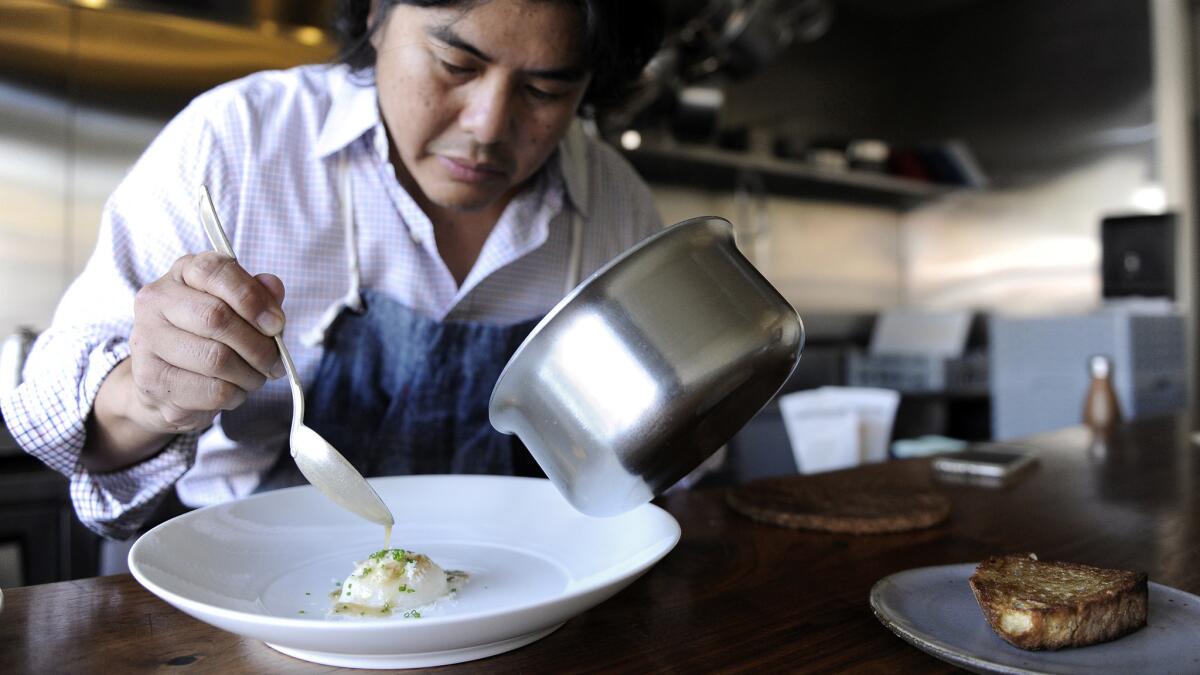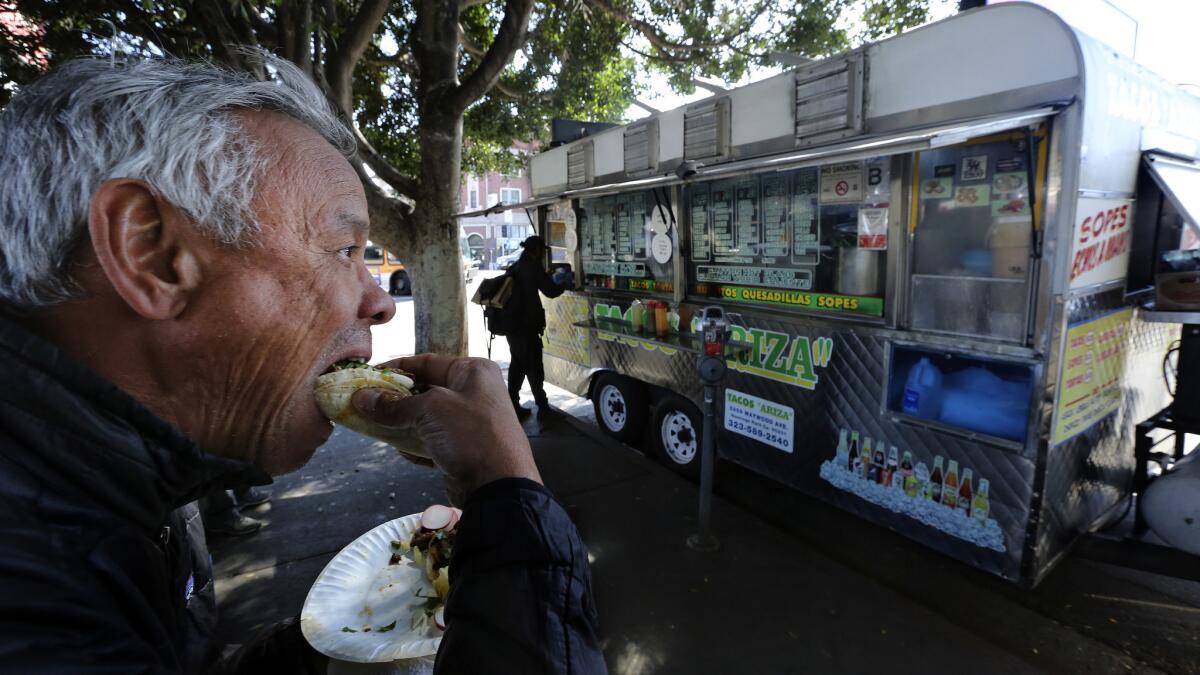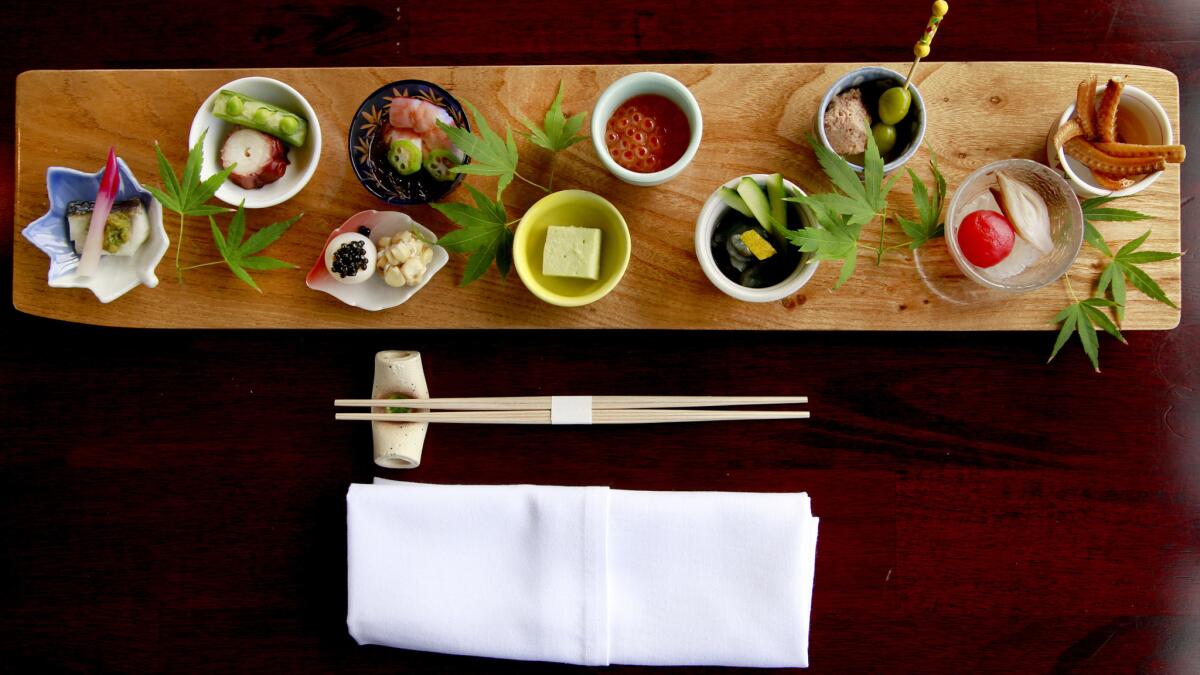What does it mean to be a chef in Los Angeles in 2017?

You know what a Los Angeles chef looks like, right? She’s the one tweezing pea shoots and celery-root chips onto a bowl of quinoa, lacto-fermenting turnips or scattering wildflowers onto a cheese pizza. Unless he’s the dude slamming carne asada onto the makeshift grill in a converted auto body shop, cultivating his own yeast cultures or slicing pigs ears into a salad.
She leans toward veganism except when she’s marinating boar collar in fish sauce and palm sugar. He wants to serve you family-style, every dish on the table at once, because that’s the way he likes to eat when he has an evening out. She has met the woman who dove for the sea urchin, the family that raised the pork, and at least three of the kids who helped grow the lettuces as part of a high school project. He will tell you that his favorite restaurant is Noma, but secretly, his fondest memory of his last trip to Copenhagen may be of the Thai noodles he ate on the way back from the airport.
Los Angeles, by most accounts, is the food city of the moment. The list of chefs set to open new places here over the next year or so — Dave Beran, April Bloomfield, David Chang, Daniel Humm, Christina Tosi, Jean-Georges Vongerichten — reads like the roster for a James Beard Award all-star game. Los Angeles-nurtured trends such as $7 toast, things in a bowl, new-wave sushi and the ubiquitous avocado continue to spread throughout the country, if not the world. Foreign visitors who used to disparage local cooking with the old Woody Allen line about mashed yeast can now tell you what might be on a pizza at Gjelina and ask nervously about the weekly schedule for the Kogi truck.
So what makes a Los Angeles chef?
There are the usual answers, which include a 12-month growing season, customers who have weaned themselves from white-tablecloth service, and a famous willingness to try new things. The access to deep-cut non-European cooking is unparalleled — it is possible in some neighborhoods to find restaurants serving a dozen regional cuisines from China or Latin America within a few minutes’ walk — and with it comes the possibility of nearly infinite new flavors and techniques, as well as young first- and second-generation chefs with different perspectives on what deliciousness might entail.

Los Angeles is by no means an inexpensive place to do business, but the cost of setting up a restaurant here is lower than it is in San Francisco and Manhattan, and some of the best restaurants here — Taco Maria, Trois Mec, Alma, Kali — began their lives as food trucks, occasional pop-ups or faded storefronts. Visitors are often astonished to discover that the restaurant they have read about in national magazines turns out to be like Chichen Itza, a stall in a community center food court, or Baroo, sandwiched between a 7-Eleven and a botanica in a dingy mini-mall.
Chefs’ success stories in other areas may be less likely to involve late-night taco tables or pop-up evening residencies at breakfast counters. Gutsiness goes a long way here, and not necessarily the kind of gutsiness that it takes to survive on the line at a temple of haute cuisine. The city is a great place to do entry-level capitalism.
Is it difficult to incorporate Vietnamese flavors when your customers are likely to have visited — or emigrated from — Hoi An? Can a decorated chef charge $18 for a bowl of pozole when the Mexican restaurant down the street charges $7.99? In a city without a harsh winter, is there ever a good time to serve choucroute, cassoulet or boeuf bourguignon?
L.A.’s place as a food city has also been as a cipher for someplace else, a narrative that can turn any way a creative chef decides it should turn. A Korean restaurant doesn’t have to look like a Korean restaurant here, but it can often feel more Korean than its counterpart in Seoul, which is feeding a different hunger.
Authenticity is obviously a relative construct — cuisines change all the time — but it becomes valuable here as kind of a benchmark; a point of reference. One of the best pizzerias here is often criticized by visiting Italians who remark that the pizza is unlike anything you taste in Italy. This is perfectly true, yet the pizzas are delicious.

The atavistic longings of Angelenos may be less for the Cobb salads, chiffon cakes and French dip sandwiches actually invented in the city than for pho, avocado toast and the kind of tacos that burn your fingers when the counterman snatches them for you straight from the grill.
And in many ways, possibly because your favorite burrito stand and your boss’s favorite Italian restaurant exist on the same continuum, Los Angeles turns out to be a democratic place in which to cook. The best chefs spend a lot of time at the farmers market — you can see them on Wednesdays in Santa Monica, gossiping and haggling over mushrooms — so the idea of great produce simply prepared becomes a default; the absolute least that is expected of a decent restaurant.
In the rest of the world, much is made of the difference between high and low cuisine. In Los Angeles, where a chef in a truck or a market stall may be as technically adept and use the same ingredients as a chef in a temple of cuisine, the line between high and low has been obliterated.
Savvy customers have access to the same produce chefs do, in a way that would have been unthinkable even a decade ago, so the appearance of salsify or mulberries on a plate may come more as an affirmation of the season than they do as a surprise. There are scores of restaurants that may resemble one another in May or October more than they do themselves the rest of the year, and a taco truck may use the same boutique produce as the kitchens at the top end of the Times 101 Best Restaurants list.
With this democracy comes freedom. A talented line cook might be a couple of phone calls away from opening her own ceviche bar or weekend pastrami concession — the era of the dictatorial chef is over. Ideas of ethnicity and gender in the kitchen can swirl and collide and recombine in new and often glorious ways. And just at the point when you think you’ve figured it out, that the culinary scene moves in predictable and hierarchical ways, a taco truck may beget the chef who redefines the Mexican tasting menu, who begets a chef who chops and channels modern Filipino cuisine.
Sometimes it’s good to take a step back, find an empty stretch of curb, and power through a crunchy shrimp taco or two from the Mariscos Jalisco truck in Boyle Heights. Because when it comes down to it, the heat, the pop of the shrimp and the rivulet of spicy juice that has already started to make its way down your sleeve may be all the validation a city’s cooking needs.
Los Angeles is a pretty good place to eat.
To read the article in Spanish, click here
L.A. Food Bowl
Food Bowl, presented by the Los Angeles Times, will celebrate L.A.’s food scene for the entire month of May, while also promoting discussion of hunger, waste and sustainability. The festival includes dining experiences, forums and a Night Market at Grand Park in downtown L.A. from May 10-14. For more information, go to lafoodbowl.com.
MORE FROM JONATHAN GOLD
Some of the best Hainan chicken in town is in an Arcadia mall
At Mas’, Jonathan Gold finds hearty, spicy food just like your Chinese Islamic mother used to make
Indian has flipped to Italian at AR Cucina and it’s time to order a negroni
More to Read
Eat your way across L.A.
Get our weekly Tasting Notes newsletter for reviews, news and more.
You may occasionally receive promotional content from the Los Angeles Times.










